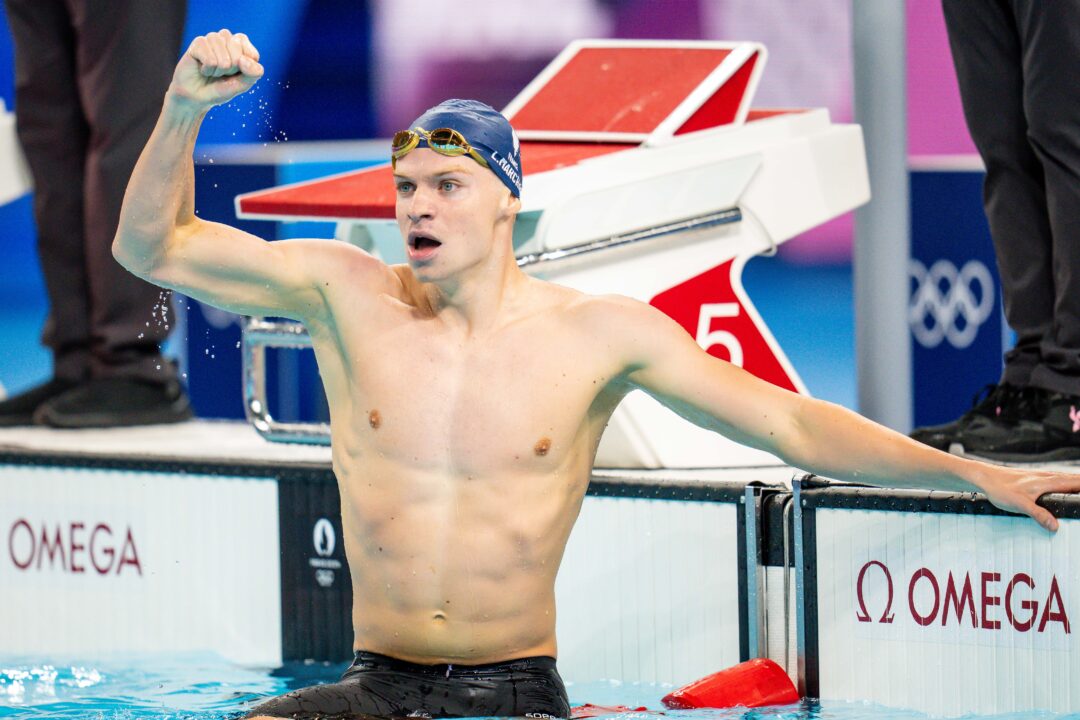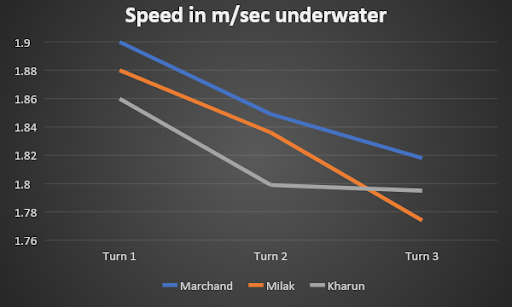Courtesy: Dominique Hérailh
This data is courtesy of the French Swimming Federation.
The French Swimming Federation has released detailed statistics on all the swimming finals at the Paris Olympics, and one of the most intriguing races of the meet, the men’s 200 fly, offers some interesting insights.
Let’s start with a general analysis of the race before going into detail. Although this article’s subject is related to the duel between Leon Marchand and Kristof Milak, it’s important to add a third man who will play an important role in the coming years, Canadian bronze medalist Ilya Kharun.
This first table gives a breakdown of the 200-meter event and the portion each athlete spent underwater.
| L. Marchand | K. Milak | I. Kharun | |
| Underwater Distance (m) | 58.1 | 51.6 | 54.4 |
| Time Underwater (sec) | 27.86 | 24.46 | 26.44 |
| Value in m/sec (D/T) | 2.085 | 2.109 | 2.057 |
| Swimming distance | 141.9 | 148.4 | 145.6 |
| Time Over The Water (sec) | 83.35 | 87.29 | 86.36 |
| Value in m/sec (D/T) | 1.702 | 1.700 | 1.686 |
- The total distance traveled underwater shows the advantage that Marchand has off the walls. Milak only travels 88.8% of Marchand’s distance underwater and Kharun is at 93.6% of his former ASU teammate.
- The speed of the underwaters brings a slight surprise. Milak is slightly faster (2.109 vs 2.085) than Marchand under the water overall, though all of his advantage came off the blocks. If we do not take into account the start in which Milak outclassed all his opponents (see table below in the article), the other three underwaters are to Marchand’s advantage (1.856 vs. 1.833 for Milak and 1.820 for Kharun).
- The swimming speed is similar between Marchand and Milak (1.702 vs 1.700) while Kharum is at 1.686.
First takeaway: Marchand has room to make up at the start while Milak has room to make up underwater.
Now, let’s break down the race by 50.
The reaction time was the same for all three swimmers: 0.67 seconds. Note however that these are the three slowest times in the field, with the fastest being Krzysztof Chmielewski (0.61).
Start To 15 Meters
| L. Marchand | K. Milak | I. Kharun | |
| Time (sec) | 5.65 | 5.39 | 5.74 |
| Value in m/sec (D/T) | 2.65 | 2.78 | 2.61 |
Milak and Marchand’s 15-meter times are 1-2 in the field, while Kharun is 4th behind Noe Ponti.
15 Meters To 50 Meters
| L. Marchand | K. Milak | I. Kharun | |
| Time (sec) | 19.31 | 18.93 | 19.32 |
| Value in m/sec (D/T) | 1.813 | 1.849 | 1.812 |
Milak has opened up a gap in this first leg. He increased his 15-meter lead from 0.26 to 0.64. The speeds of Marchand and Kharun are essentially identical.
First Turn
| L. Marchand | K. Milak | I. Kharun | |
| Underwater (m) | 14.95 | 13.46 | 13.82 |
| Time (sec) | 7.87 | 7.15 | 7.42 |
| Value in m/sec (D/T) | 1.90 | 1.88 | 1.86 |
Not only did Marchand travel the farthest off the first turn, but he was also traveling the fastest which allowed him to gain 12 one-hundredths under water. The 15-meter splits were: Marchand 7.90, Milak 8.02 and Kharun 8.10. At 65 meters the situation is as follows: Milak 32.34, Marchand +0.52 and Kharun +0.82.
65 Meters to 100 Meters
| L. Marchand | K. Milak | I. Kharun | |
| Time (sec) | 20.60 | 20.52 | 20.51 |
| Value in m/sec (D/T) | 1.699 | 1.705 | 1.706 |
In this segment, Milak did not completely absorb the advantage of Marchand obtained on the underwater, but was close (0.08 vs 0.12). Kharun, seeing himself slightly behind at 65 meters, produced his effort to try to catch up with the two leading swimmers. At 100 metres the ranking is as follows: Milak 52.86, Marchand +0.60 and Kharun +0.81.
Second turn
| L. Marchand | K. Milak | I. Kharun | |
| Underwater Distance (m) | 13.20 | 11.75 | 12.52 |
| Time (sec) | 7.14 | 6.40 | 6.96 |
| Value in m/sec (D/T) | 1.849 | 1.836 | 1.799 |
Again, Marchand traveled the farthest and was the fastest underwater. At 115 meters, Milak held the lead with a time of 1:01.06 followed by Marchand +0.57 and Kharun +1.05
115 Meters To 150 Meters
| L. Marchand | K. Milak | I. Kharun | |
| Time (sec) | 20.61 | 20.46 | 20.93 |
| Value in m/sec (D/T) | 1.698 | 1.711 | 1.672 |
While Marchand was perfectly consistent in scoring the same time with a hundredth of a second as he did from 65 to 100, Milak put in a surge that may have compromised his chances of winning. At 150 metres the ranking was as follows: Milak 1:21.52, Marchand +0.72 and Kharun +1.52.
Third turn
| L. Marchand | K. Milak | I. Kharun | |
| Underwater Distance (m) | 14.11 | 11.11 | 12.39 |
| Time (sec) | 7.76 | 6.26 | 6.90 |
| Value in m/sec (D/T) | 1.818 | 1.774 | 1.795 |
The third turn marks the start of the climb that will see Marchand close the fastest and ultimately win. At 165 meters, Milak was still leading with a time of 1:30.09 followed by Marchand at 0.41 and Kharun +1.44.
165 Meters To 200 Meters
| L. Marchand | K. Milak | I. Kharun | |
| Time (sec) | 20.71 | 21.66 | 21.27 |
| Value in m/sec (D/T) | 1.690 | 1.616 | 1.646 |
At the finish, Marchand touched in 1:51.21 followed by Milak (1:51.75) and Kharun (1:52.80).
Marchand’s consistency over the last three 50s over the water (35-meter speed is notable: 1.699, 1.698 and 1.690, a standard deviation of 0.00411. So we can think that he built his race by measuring his efforts up to 150 meters without worrying about the lead taken by Milak.
Milak was far less consistent across the closing three 50s over the water. His speeds were 1.705, 17.11 and 1.616, a standard deviation of 0.04342.
Kharun also measured his efforts better than Milak: 1.706, 1.672 and 1.646 for a standard deviation of 0.02463 or a lower dispersion of data than those of Milak but shy of Marchand.
This last graph shows the underwater speeds achieved during the 3 turns. The third turn clearly shows the drop in Milak’s regime which will be confirmed in the last length.
Conclusion
In my opinion, Marchand won because he built his race better than Milak. Swimming with more consistency, he was able to keep something in reserve to finish his last 50 in 28.97 which is more than one second faster than Milak. On the other hand, the length of his underwaters and the speed with which he made them allowed him to remain in contact until the last 50.
Milak was perhaps too confident that he could establish an early lead and stay away, or knew going out fast was his best chance to win. His push on the third 50 resulted in him not leaving enough in the tank for the last length, where Marchand made his move. Knowing that he was perhaps a little short in closing speed, he tried to build up an advance before the last leg but this proved insufficient.
Kharun made a race that is somewhat symmetrical with Marchand’s but less effective in the underwaters and a little slower over the water.
Anyway, these three swimmers gave us a show that made not only the spectators of the Arena Défense but also all those who were in front of their screens. Michael Phelps’s reaction, filmed by NBC, will be remembered forever.



What I’m wondering about now is whether Milak will want to regain the 200fly crown or focus on the 100fly 100free double which I think is closer to his heart.
I think they are both well established swimmers but i still don’t get how Marchand got that back half speed
It’s straightforward:
Milak wasn’t in his top form on that day.
Marchand outswam Milak in the finals courtesy of his turning techniques NOT en route strokes & kicks.
Milak has to prove himself again. As of now Marchand is the 200 fly GOAT.
Yeah not the guy who set the WR as a 16 year old and held it for 18 years while winning 3 olympics golds in the event…
Phelps is the 200 fly GOAT end of discussion lol
Was good, but this is an another era. With 1:51:51 you can’t win anything as you can see.
Facts are facts.
Leon is the second. Milak doesn’t need to prove anybody anything. He has the WR.
Tell us you’re a newbie to swimming without telling us that you’re a newbie to swimming….
Marchand is the 200 fly GOAT just because he won at this Olympics? Good joke. He never went sub 1:51 so far while Milak has two world records and he is the current world record holder with 1:50.34. Milak is by far the better swimmer in butterfly, just because he wasn’t in 100% shape it doesn’t mean Marchand is the best ever lol.
Would love to see the 200 br breakdown since his strategy was the opposite from this 200 fly, take it out and hang on
Marchand’s last underwater in this race was the most beautiful swimming I’ve ever seen.
not sure about the last line in the article – “…will be…remembered forever” I had forgotten all about it.
One thing that is also worth considering is for those who do shorter underwaters the data for average speed (i am assuming that is what we are seeing here) will be effected more by the push off the wall. Since the push off the wall and the short subsequent period of deceleration are the fastest portions of the UW, and the UW is significantly shorter than another persons, then it will have a greater influence on the metric of average speed.